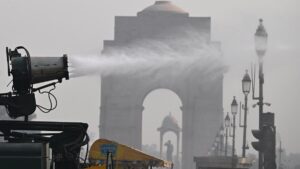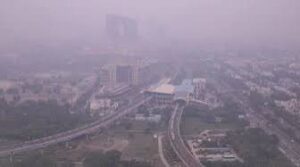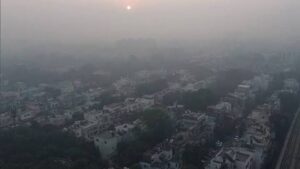Digital News Guru New Delhi Desk:
Delhi government’s order to run offices with 50% staff due to rising air pollution
As air pollution in Delhi surges to alarming levels, the Delhi government has taken a decisive step: ordering both public and private offices to restrict their physical workforce to just 50%, with the remainder working from home. The directive, issued under Stage III of the Graded Response Action Plan (GRAP), marks a renewed attempt to curb emissions and protect public health.
Why This Step Was Taken
Delhi’s air quality has deteriorated sharply, with PM2.5 and PM10 concentrations persistently breaching safe thresholds. According to the Commission for Air Quality Management (CAQM) and Delhi’s Environment & Forests Department, the situation demands urgent action.

To respond, the government has activated Stage III of GRAP, which corresponds to a “very poor” to “severe” air quality scenario. Under this stage, a suite of emergency measures—typically reserved for more extreme pollution levels—has been brought into effect earlier than before.
What the Order Says
- On-site strength capped at 50%: All government and private offices across Delhi must operate such that not more than half their workforce is physically present.
- Mandatory work-from-home: The remaining staff members must work remotely, effectively halving the daily commuter load.
- Staggered office hours: To minimize peak-hour traffic and emissions, private offices are asked to stagger working hours.
- Minimize commuting emissions: Offices must adopt policies to reduce vehicular travel associated with commuting, such as tighter WFH implementation and carpooling or shared transport.
- Essential services exempt: Key services—such as hospitals, fire services, water and electricity utilities, sanitation departments, and pollution-control teams—are excluded from the 50% cap.
- Strict enforcement: District magistrates, police, and local civic bodies have been instructed to oversee compliance. Violations could lead to penalties under Sections 15 and 16 of the Environment (Protection) Act, 1986.
The Legal & Policy Basis
The directive is rooted in environmental law. Issued by Delhi’s Environment & Forests Department, the order invokes Section 5 of the Environment (Protection) Act, 1986, granting the government authority to take extraordinary measures in the face of environmental emergencies.
Moreover, the shift of the 50% staffing rule from GRAP Stage IV to Stage III reflects a recalibration of the GRAP system. The CAQM, following a Supreme Court hearing, proposed this change to enable earlier intervention, rather than waiting for pollution to worsen to the “severe+” level.

Implications and Challenges
- Public health safeguard
At its core, the move aims to reduce the number of commuters and associated vehicular emissions—one of the biggest contributors to Delhi’s winter smog. Fewer vehicles on the road could help lower pollution levels, especially during peak congestion hours. - Work culture shift
This directive could accelerate the normalization of hybrid work in Delhi’s corporate and government sectors. Many industries may now build more flexible work-from-home policies into their long-term operations, even beyond crisis periods. - Economic trade-offs
While remote work helps in reducing emissions, it may not suit all job functions. Certain sectors—like manufacturing, labs, or services requiring physical presence—could find compliance difficult, potentially affecting productivity. - Enforcement burden
The effectiveness of this order depends heavily on enforcement. Local authorities will need to monitor compliance rigorously and penalize violations. Given past criticisms that GRAP measures are not always enforced strictly, this could be a sticking point. - Forecasting issues
Experts have long flagged that GRAP’s activation has suffered from forecasting delays. The CAQM’s earlier reliance on air-quality models hasn’t always translated into timely action, and there are calls to move even more Stage IV measures into earlier stages. - Public response
While many may welcome the health-driven move, questions remain about its sustainability and equity. Will private companies comply fully? Will employees face pressure to come in despite the rule? And how will this order affect daily operations in small businesses that cannot easily transition to remote work?
Context: Broader Pollution Measures
The 50% work-from-home mandate is just one of several steps being taken under the current GRAP framework:
- Anti-smog guns: The Delhi government recently ordered the installation of 107 “anti-smog guns” on tall buildings to disperse particulate matter.
- Revised office timings: The government has also introduced staggered office hours for various departments to reduce peak-time pollution.
- Public communication: Authorities are issuing pollution alerts via traditional media, and urging citizens to limit travel, use shared transport, and avoid outdoor activities during high-pollution days.
Risks & Criticisms
Some analysts and environmentalists argue that such measures, while necessary, are not sufficient on their own. There are concerns that agencies are being reactive rather than proactive. As one report pointed out, enforcement of GRAP Stage III has sometimes remained superficial, with dust and construction-related pollution continuing unchecked.

Others call for a more systemic overhaul: better forecasting systems, stricter long-term policies on construction emissions, stricter regulation of industrial sources, and coordination with neighboring states to address cross-border pollution.
Conclusion
Delhi’s decision to cap office attendance at 50% during its most polluted days is a stark reminder of the severity of its air crisis. By invoking GRAP Stage III measures, the government is signaling that the days of mild advisories are over—urgent, legally enforceable steps are now underway to limit harm and protect public health.
However, the success of this move will depend on more than just policy announcements. Effective enforcement, corporate buy-in, and a sustained commitment to deeper pollution-control reforms will be critical. If implemented seriously, this could not only bring short-term relief but also push Delhi further along the path toward cleaner, more sustainable air—and a more resilient work culture.
You May Also Read: Rajnath Singh Says “Sindh May Return to India”: Civilisational Claim Sparks Controversy








